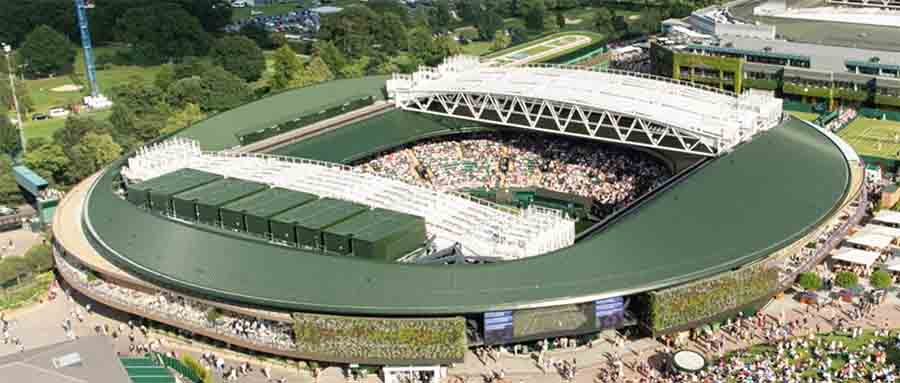No 1 Court
The award-winning facilities enhance the quality of the spectator and player experience, thereby supporting AELTC’s aim of maintaining Wimbledon’s status as the premier Grand Slam event in world tennis.
Opened in 1997, it is used primarily for the Wimbledon Championships. It also occasionally plays host to Great Britain’s Davis Cup home ties, as Centre Court is reserved for the Grand Slam tournament, with the one exception of the 2012 Olympic Games.
With a capacity of 15,000, it replaced the original, now-demolished No. 1 Court, which had stood on the west side of Centre Court since 1924, with a spectator capacity of 7,328. The old court was replaced by the Millennium Building, the media centre and facilities for players, members, and officials.

A fully retractable roof was completed in 2009, and capacity increased to 15,000 by adding six rows of seats to the upper tier on the east, north, and west sides. New media facilities, scoreboards including video, and commentary boxes were built to replace those currently in the upper tier. New wider seats were installed and new additional stairs and lifts were added.
History
The name “Centre Court” derives from the location of the principal court at the All England Croquet Club’s original site off Worple Road, Wimbledon – where the main court was located in the centre of all the other courts.For the first Wimbledon Championship in 1877 a total of 12 courts were available which were laid out in a 3×4 grid and there was no actual centre court. This changed in 1881 when the middle two courts of the middle row were combined to form a Centre Court. The name was kept when the club relocated to its present site at Church Road in 1922. It was not until a further four courts were added in 1980 that Centre Court’s location in the grounds again matched its name.
The initial capacity of the Centre Court is not known. In 1881 temporary covered stands (A, B and C) were erected on three sides of the Centre Court and in 1884 stand A was converted into a permanent stand, to be followed in 1885 by the conversion of stands B and C. In 1886 the three stands were joined at the corners to form a continuous structure. The stands were considerably enlarged in 1906 and in 1909 a new stand B was constructed increasing capacity by 600 seats. In 1914 the seating capacity was increased from 2,300 to 3,500 and this remained unchanged until the move to the new ground at Church Road.
The court suffered from bomb damage during World War II when five 500 lb bombs hit the Centre Court during an air attack in October 1940. 1,200 seats in the stadium were destroyed and although play resumed on time after the war in 1946, the court wasn’t fully repaired until 1949.
The original centre court roof from 1922, which partly covers the stands, has been modified several times. In 1979, it was raised by one metre to allow the capacity to be increased by 1,088. Further building work came in 1992 with a replacement of the roof and a modified structure which allowed 3,601 seats to have a clearer view of the court which had previously been restricted by the number of roof supports.



